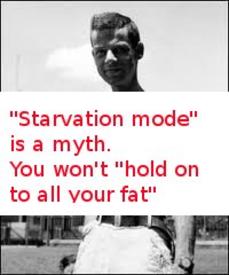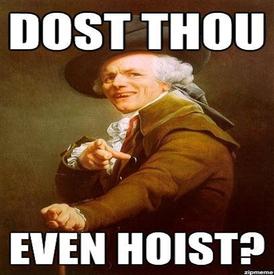Cardio & fat loss

yarwell
Posts: 10,477 Member
Is it better to do 300 calories of easier cardio with a 60% fat burn based on heart rate (180 cals or 20g of fat), or to do 500 calories of harder cardio with 30% fat burn (150 cals of fat) ?
The non-fat burn is presumably carbs and glycogen which are then replenished fairly quickly, but does the greater overall burn contribute to more fat loss per day if the exerciser is also dieting with a calorie deficit of say 15%. Obviously the fat burn during the exercise is greater in the easier case, but what about the overall effect.
The non-fat burn is presumably carbs and glycogen which are then replenished fairly quickly, but does the greater overall burn contribute to more fat loss per day if the exerciser is also dieting with a calorie deficit of say 15%. Obviously the fat burn during the exercise is greater in the easier case, but what about the overall effect.
0
Replies
-
I say the higher burn. First, you can still lose fat. Secondly, you can eat more if you want. Thirdly, you're working your cardiovascular system for better overall heart health.
But then I like to run. And I like to eat.0 -
I believe you'll burn more fat doing shorter high intensity workouts like Tabata, HIIT or Burst training.0
-
High intensity is better, but you also need to rest more often, so what i would do is 1 day high intensity 1 day low intensty, repeat
http://www.ncbi.nlm.nih.gov/pmc/articles/PMC2730190/?tool=pmcentrezHIT training produced more fat loss. In between LT and VO2max. It was progressive so each person met the constant calorie burn.
Agreed.. This has been my approach. High intensity every other day and low intensity on the opposite day's. Been working very well for me...0 -
I would say low intensity would be best at burning fat , but I would rather run 45 min then do strength training which burns fat and builds muscle, but if i were able to do one or the other ,and i only had my 2 legs for cardio and we are talking only fat loss ,i would prob just do low intensity for longer periods of time. keeping my HR between 130--145 bpm0
-
I was contemplating the information in www.freemotionfitness.com/wcsstore/Freemotion/Attachment/Education/Incline_Training.pdf which shows higher per minute fat loss at lower speeds / moderate gradients during the actual exercise.
The missing bit was what happened in the rest of the 24 hours or week as a consequence of calories burned.
High intensity interval training does seem to be the best, the current question is what's the best for a treadmill junkie who currentyl goes flat out in pursuit of big numbers on the machine (objective is fat loss).0 -
You may find this relevant. While it's from 2006, my assumption is that the information would be updated if it were no longer considered current:
http://alanaragon.com/myths-under-the-microscope-the-fat-burning-zone-fasted-cardio.html0 -
It's not referring to "Fat Loss" but "Fat Utilization"- in other words its referring to the percentage of stored fat as fuel during the cardio at lower speeds. Just because this percentage is greater doesn't mean that the body is burning its stored fat more efficiently, let alone more of it.
Besides, if low-speed cardio was more efficient at burning bodyfat, why aren't more people ripped? How come the power walkers at the mall aren't sporting 6-packs?0 -
Ultimately what matters is total calories used - higher intensity, higher burn. The bonus is the improved cardiovascular workout.
http://www.canada.com/topics/bodyandhealth/story.html?id=1740622b-d130-486c-a4d3-f05d14878ff90 -
High Intensity:
+ Burns more calories per minute
- Takes longer to recover from
- Cannot be sustained as long, and cannot be done as frequently
Low/Medium intensity
- Burns fewer calories per minute
+ Can be done more frequently and for longer duration
+ Does not hinder recovery (may enhance it)
Instead of looking at each type of cardio in isolation, see how it fits in with your overall training regimen. How much time do you have available? What are your overall goals?
Choose the type (or mixture of the two) that best suits your personal circumstances. This could be one or the other, both, or none at all.0 -
Bump interesting post.0
-
It's not referring to "Fat Loss" but "Fat Utilization"- in other words its referring to the percentage of stored fat as fuel during the cardio at lower speeds. Just because this percentage is greater doesn't mean that the body is burning its stored fat more efficiently, let alone more of it.
Besides, if low-speed cardio was more efficient at burning bodyfat, why aren't more people ripped? How come the power walkers at the mall aren't sporting 6-packs?
Good point....0 -
http://www.ncbi.nlm.nih.gov/pmc/articles/PMC2885974/ comes to some conclusions -
"Indeed, the plethora of studies that demonstrate that exercise produces less than an expected weight loss appears consistent with our conclusion that in non-fasted individuals, exercise has little effect on daily fat oxidation."
"Clearly, exercise intensity does not have an effect on daily fat balance, if intake is unchanged. We must educate the public that participation in moderate doses of exercise will not burn more fat unless changes are made to energy or fat intake."0 -
switch off...doing both....changing it up is great for many reasons0
-
High intensity is better, but you also need to rest more often, so what i would do is 1 day high intensity 1 day low intensty, repeat
http://www.ncbi.nlm.nih.gov/pmc/articles/PMC2730190/?tool=pmcentrezHIT training produced more fat loss. In between LT and VO2max. It was progressive so each person met the constant calorie burn.
Agree with this. If you're truly doing high intensity intervals, you wouldn't be able to do it for very long, much less every day. Also, something to consider is how much time do you have a day to exercise (and other limitations). For example, if you can do cardio for 2 hrs, you will probably be able to burn more calories in comparison to a 20 min HIIT session, even if you account for "after-burn" effect.0 -
As several have said, ultimately it is calories burned. I suspect the confusing claim is the 60-70% zone "burn fat" more than the 70-80% zone. As clarified it may that more fat is "utilized" during the exercise not necessarily more is ultimately lost.
One of several easily misinterpreted folklore sayings.0 -
If you are eatig back calories it doesn't matter, otherwise depends on your goal. If you are significantly overweight and trying to drop weight, go for the higher burn. If you are already leanish and trying to work on losing fat while preserving your remaining muscle, then low intensity is way better. In case you don't already know, muscle preservation is much better the higher your body fat percent. The leaner you get, the more your body prefers muscle to fat.0
-
Anaerobic exerise is more efficient in terms of calorie burn over time, and is not usually accounted for in calculations due to the exact number of calories burned in recovery being poorly understood. In most cases, burning X calories in HIIT should be at least slightly more efficient than X calories burned in steady state cardio. Heavy weight training really capitalizes on this in terms of anaerobic volume per unit of time, but typically produces a smaller initial burn per unit of time vs HIIT.0
Categories
- All Categories
- 1.4M Health, Wellness and Goals
- 393.4K Introduce Yourself
- 43.8K Getting Started
- 260.2K Health and Weight Loss
- 175.9K Food and Nutrition
- 47.4K Recipes
- 232.5K Fitness and Exercise
- 427 Sleep, Mindfulness and Overall Wellness
- 6.5K Goal: Maintaining Weight
- 8.5K Goal: Gaining Weight and Body Building
- 153K Motivation and Support
- 8K Challenges
- 1.3K Debate Club
- 96.3K Chit-Chat
- 2.5K Fun and Games
- 3.7K MyFitnessPal Information
- 24 News and Announcements
- 1.1K Feature Suggestions and Ideas
- 2.6K MyFitnessPal Tech Support Questions











